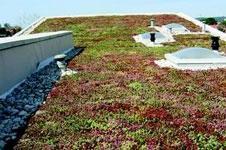Green roofs may have environmental benefits, but what do they cost to install and maintain? Peter Mayer of Building LifePlans talks us through the issues
Green roofs are promoted as a means of achieving more sustainable buildings as they improve the durability of waterproofing materials, provide flora, fauna and space and reduce rainwater run–off.
Green roofs come in two types: intensive and extensive. Intensive systems, or roof gardens, tend to have deeper soil that designers can use to create more or less any type of eco-system, including trees, bushes and shrubs, as well as grasses and flowering plants. Simple intensive or semi-intensive green roofs are subtypes based on grasses, herbaceous plants, shrubs or coppices.
Extensive green roofs use shallower soil depths and planting is limited to members of the sedum family: mosses, herbaceous plants and grasses. Less maintenance tends to be required for this type of roof.
Whichever approach you go for, the capital and maintenance costs are likely to be higher than for a conventional roof, and if there is a leak, remedial costs may be high. However, a lifecycle analysis may demonstrate that long-term benefits offset these costs.
Building green roofs
Green roof systems can be placed on inverted, warm or cold roofs, in either a flat or pitched configuration. The most common arrangements are flat inverted or warm roofs.
It is important to make sure the structure can withstand the load, including the weight of fully grown plants and any temporary equipment that is likely to be placed on it.
Higher costs are associated with pitched roofs on account of the additional safety measures that may be required for construction and maintenance.
Many waterproofing systems can be used on green roofs. If the waterproofing layer is shielded from the sun, service life can be prolonged by between 10% and 100%.
Green roofs have an insulating effect, which varies with the planting, time of year, their moisture content and the growing media used. Savings may be achieved by reducing building insulation thickness and heating and cooling mechanisms.
Cutting the risk of leakage is key to ensuring reasonable lifecycle costs. To avoid penetrations through the roof, check that the waterproofing layer is 150mm above the growing layer at abutments and carry out an integrity test on the waterproofing layer before laying the green roof. To ensure adequate drainage, flat roofs should be laid to a fall of 1:40. This avoids ponding and should accommodate construction tolerances.
A separate root barrier may be required to protect the waterproofing membrane, especially if planting includes aggressive rhizomes. A waterproofing membrane can act as a root barrier and should comply with BS EN 13948, the standard for resistance to root penetration
A drainage layer is also essential for planting and water attenuation. Options include porous mats, corrugated plastics sheets, or granular material.
Growing media should be suited to the planting. There is a huge choice, from completely synthetic materials such as lightweight resin granules, which retain moisture, through to traditional soil systems that could be taken from the original site and reused.
Whole-life cost considerations
There are several environmental benefits that could be offset against the capital and maintenance costs of a green roof. It is not always straightforward to translate these into monetary value for a whole-life cost assessment, but some are mentioned in the Code for Sustainable Homes:
- Water attenuation
- Increased amenity space
- The absorption of airborne particles
- Increase in local biodiversity.
Maintenance issues
Maintenance depends on the planting and microclimate. Activities include:
- Keeping drainage outlets clear
- Inspecting the waterproofing layer where visible
- Watering, if required (automatic irrigation comes at higher capital costs)
- Weeding. Plant replacement and removal of unwanted material is labour-intensive but important to maintain the amenity
- Fertilising. Annual application of slow-release type for extensive green roofs. Intensive planting may incorporate nutrient-rich soils with specific fertilisation requirements.
Table notes
A discount rate of 3% is used to calculate net present values. Costs are for growing layer and planting only, including continuing maintenance: weeding,
fertilisation, allowance for replacement substrate, planting and occasional irrigation. Structure, waterproofing, insulation and drainage system are excluded. Costs are indicative and represent the average of a range.
No attempt has been made to include environmental benefits. A cost analysis based on project-specific information is essential for a realistic best-value appraisal, including environmental trade-offs. The cost for small roofs would be proportionately higher. Planting and growing media are not given service lives as their performance is related to maintenance. The lifecycle costing allows for a major overhaul between years 20–30. BLP Insurance provides latent defect warranties for buildings www.blpinsurance.com.
Specifier 03 October 2008
- 1
- 2
- 3
- 4
- 5
- 6
- 7
- 8
- 9
- 10
- 11
- 12
- 13
- 14
- 15
- 16
- 17
- 18
- 19
 Currently reading
Currently readingWhat it costs: Green roofs
































2 Readers' comments